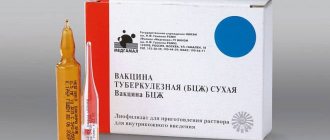Indications for Tuberculin vaccination
Tuberculin is used for tuberculin diagnostics (carrying out an intradermal Mantoux tuberculin test), which is an indicative diagnostic test for the purpose of:
- identifying the need for a patient to be vaccinated against tuberculosis with BCG
- diagnosis of tuberculosis;
- determining whether the population is infected with Mycobacterium tuberculosis (or the state of hypersensitivity to tuberculin, if the existing post-vaccination allergy does not give grounds to talk about infection).
The active substance of the drug (allergen-tuberculoprotein) causes, when performing an intradermal tuberculin test in people infected or vaccinated with BCG/BCG-M, a specific delayed-type hypersensitivity reaction in the form of a local reaction - hyperemia (redness) and infiltrate (papule formation).
Mantoux test
The Mantoux test is performed annually on all children under 7 years of age. This is not a vaccination (!), but an immunological test that shows whether the tuberculosis pathogen is in the body. In this case, tuberculin, a specific protein containing antigens of human and bovine tuberculosis, is injected intradermally. After 72 hours, the size of the papule is measured. The result of the Mantoux reaction can be affected by visiting a sauna, taking a long bath, swimming in a swimming pool, and scratching the injection site. Temporary contact with water does not in any way affect the results of the Mantoux test, therefore the opinion that Mantoux cannot be wetted is a myth.
Evaluation of Mantoux test results
The test result is assessed by a doctor or trained nurse 72 hours after the test. A reaction to tuberculin is possible in the form of hyperemia (redness of the skin) and the formation of a papule (a dense round area rising above the skin). Assessment of the Mantoux test consists of taking into account the size of the papule and assessing the severity of hyperemia. The measurement is carried out in a direction transverse to the axis of the hand, the result is taken into account in millimeters. Only the size of the papule is measured, and not the size of the area of hyperemia (redness). The size of the redness is taken into account only when the papule has not occurred.
Reaction options for the Mantoux test:
- negative - there are no changes on the skin;
- doubtful - there is redness of any size without a papule, or a papule no more than 2-4 mm;
- positive mild - papule size 5-9 mm;
- positive of medium intensity - papule size 10-14 mm;
- positive pronounced - papule size 15-16 mm;
- excessive (hyperergic) - the size of the papule exceeds 17 mm or there are pronounced signs of inflammation (reaction of the lymph nodes, skin ulceration, etc.).
- A negative Mantoux reaction indicates that the body does not have antibodies that are “familiar” with the tuberculosis bacterium. This means that the child is not infected, or there is no immune reaction to BCG vaccination.
- A questionable sample is considered negative.
- A positive test can be either a consequence of BCG vaccination or a sign of infection.
To assess the likelihood of infection, you need to look at the turn of the tuberculin test - the transition of a negative Mantoux reaction to a positive one (not associated with previous vaccination) or an increase in the diameter of the papule compared to the result of the previous test by 6 millimeters or more.
Also signs of infection are:
- hyperergic reaction;
- persistent (more than 4 years) persistent reaction with a papule of 12 mm or more;
- gradual (over several years) increase in sensitivity to tuberculin with the formation of an infiltrate measuring 12 mm or more.
A positive Mantoux test result without taking into account other diagnostic criteria is not a basis for making a diagnosis or starting any treatment.
Only a doctor can evaluate the reaction; if necessary, the child will be referred for additional examination to a TB specialist.
Mantoux reaction size indicators by age
The norm of Mantoux indicators varies depending on age. In children, the size of the papule should be smaller than in adults.
The first check is done at 12 months, that is, a year after the administration of the BCG vaccine (against tuberculosis).
The size of the button in this case depends on whether the child has developed immunity or not. When the vaccine affects the body correctly, the readings will vary from 5 to 11 mm. If there is no reaction, it means that the defense has not formed, and you need to check the baby more often.
At the age of 2 to 4 years, the above indicators remain approximately the same. Most children have papules larger than 5 mm but smaller than 10 mm.
By the age of 5-6 years, the baby practically loses immunity to Koch's bacillus, and therefore the reaction to tuberculin becomes weaker. During this period, the button does not exceed 6 mm in size.
At 7 years of age, BCG vaccination can be repeated. The body’s further reaction to Mantoux depends on whether another vaccination was given.
If BCG was administered, the papule increases and then decreases. At 8 years old it can reach 11 mm, and by 14 it decreases again to 5 mm.
In unvaccinated children between the ages of 7 and 14, a false or questionable reaction persists: the papule is no more than 4 mm.
For adults (starting from 14 years old), the Mantoux size should not be larger than 16 or 20 mm (for teenagers and people over 18, respectively). If the button exceeds 17 or 21 mm, the reaction is considered positive.
Indications for the Mantoux test
The Mantoux test is performed to diagnose tuberculosis.
Children vaccinated against tuberculosis:
The Mantoux test (Intradermal allergy test with tuberculin) is performed once a year, regardless of the results of previous tests, at the age of 1 to 7 years inclusive.
For children not vaccinated against tuberculosis (children who have not been vaccinated with BCG), the Mantoux test is performed 2 times a year starting at the age of 6 months
Children not vaccinated against tuberculosis:
The Mantoux test is performed - 2 times a year, starting from the age of 6 months, the Mantoux test is performed.
How to make Mantoux
The Mantoux reaction is done subcutaneously by injecting a special solution. It contains tuberculin - inactive particles of the causative agent of the disease, Koch's bacillus. The substance is safe for the body and cannot cause tuberculosis, however, it is used to test the presence of immunity against the Koch bacterium.
The active substance solution is injected into the center of the forearm using a disposable syringe.
The fluid accumulates under the skin and forms a button. If Mantoux tests are performed annually, the patient's hands are constantly changed: alternating right with left.
The level of immune reaction is determined by the size of the button that forms at the site of injection of inactivated Koch bacilli. The larger and brighter the color, the more likely it is that the patient has ever been in contact with the causative agent of the disease. If a person is currently infected with tuberculosis, as a result of the injection of the substance, suppuration may even develop at the injection site after some time.
Determine whether a child or adult is at risk of contracting tuberculosis by checking the Mantoux indicators (button size) with the normal values in the table. When making comparisons, a permissible deviation of several millimeters is taken into account, but if the compaction clearly exceeds the norm, the patient is sent for additional examinations with suspected tuberculosis.
The reason to believe that a person is infected with the disease is a sharp jump in the size of the papule (For example, before it was 8 mm, but during the next vaccination it is already 15 mm), exceeding 12 mm for 4 years, as well as severe redness and suppuration of the button.
Contraindications
Only a doctor can decide whether the drug “Tuberculin” is suitable for testing for tuberculosis.
“Tuberculin” is contraindicated for persons with allergic and autoimmune diseases!
The use of Tuberculin is also contraindicated in the following cases:
- common skin diseases
- epilepsy
- acute, chronic infectious and somatic diseases during exacerbation; allergic conditions (rheumatism in acute and subacute phases, bronchial asthma, idiosyncrasies with pronounced skin manifestations during exacerbation).
It is not allowed to carry out the Mantoux test in those children's groups where there is a quarantine for childhood infections. The Mantoux test is performed 1 month after all clinical symptoms disappear or immediately after quarantine is lifted.
Contraindications to the Mantoux test
Children and adults are not allowed to undergo testing if they have recently suffered an acute illness. Mantoux should not be given to patients with a cold, cough, fever, sore throat, or suspected flu.
A strict contraindication to the reaction is the presence of an allergy to phenol or tuberculin.
If the test substance is administered to a patient with intolerance, this can lead not only to distorted results, but also to severe allergic manifestations (itching, rash, swelling, suppuration).
If a person received any type of vaccination less than a month ago, the test will have to be temporarily postponed. Procedures that affect the immune system are a contraindication to the test (except for taking weak strengthening drugs).
The specialist will not administer tuberculin if a rash, hives, or other signs of allergy have been detected on the skin.
The test is not done even when a viral or infectious disease was suffered less than a month ago. To carry out a full reaction, you must wait until 30 days have passed from the moment of recovery.
Tuberculin is not administered to epileptics.
Possible side effects
- For most, the test process is asymptomatic.
- Headaches may rarely occur
- General weakness, sleep disturbances, and increased body temperature rarely develop.
- Individuals with altered reactivity experience allergic reactions.
- Considering the possibility of developing immediate allergic reactions (anaphylactic shock, Quincke's edema, urticaria) in particularly sensitive individuals, vaccinated persons must be provided with medical supervision for 30 minutes.
Come get vaccinated at Aqua-Doctor. A full range of vaccines for children and adults, family vaccinations - at a special price!
Call a doctor at home Make an appointment with a doctor Or by phone +7
Reasons why the Mantoux test result may be false
The main reason for the erroneous indicator is violation of the doctor’s instructions in the three-day period after the administration of tuberculin.
Main rules:
- do not rub or scratch the papule;
- do not apply cosmetics or medications to the skin at the site of the allergy test;
- avoid hypothermia.
If one of the rules is violated, the test result is unlikely to be reliable. Even with the slightest deviation from the instructions, the development of a false positive reaction is possible.
Parents are often to blame for blurry readings. They confuse the preparatory procedures before vaccination with the rules for preparing for Mantoux. All that needs to be done before using tuberculin is to make sure that there are no contraindications to the test.
However, parents can give their baby antihistamines and antipyretic drugs on the day of using tuberculin in order to alleviate children's adverse reactions to Mantoux. The use of analgesics and antiallergic medications seriously distorts the result.
A false positive reaction may occur if the child has recently been vaccinated with BCG.
This is a vaccine that is used to create immunity against Koch bacillus in children. An increased reaction after administration of the test solution is observed in children within 3-4 years after vaccination. That is, at the age of up to 4-5 years and from 7 to 10, they may exhibit severe allergic reactions, which are not a reason to go to a tuberculosis clinic.
Sometimes the buttons begin to fester not due to the development of Koch's bacillus in the body, but due to severe allergic reactions. In this case, in order to distinguish the disease from individual intolerance, the patient is given antihistamines.
When conducting a test during an acute respiratory infection, viral disease, fever or fever, readings cannot be taken at all. They will be incorrect in any case. Various vaccinations done less than a month ago negatively affect the reliability of the result.
Contrary to popular belief, water ingress cannot distort the result. Since tuberculin enters the body with a thin needle, neither air nor water can enter the hole.









